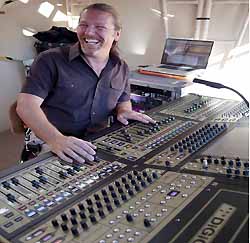Deborah Harry and her band Blondie are still going strong nearly 40 years since they got together. The lineup these days includes core members Chris Stein on guitar and drummer Clem Burke, along with Matt Katz-Bohen on keyboards, Lee Fox on bass, and Tommy Kessler on guitar.
The group took to the road in 2011 in support of Panic of Girls, their ninth studio album. At the tour’s audio controls was Rod Nielsen of Austin, TX-based Big House Sound on a DiGiCo SD8/DRack system.
Nielsen actually purchased two SD8s over three years ago to fill the bill for the Blondie and Blues Traveler tours, as well as to accommodate specific rental requests. With the release of the new Blondie record, Nielsen packed up the SD8 last spring for nearly five weeks of gigs throughout Europe and the UK.
The console’s diminutive size gave him the luxury of shipping it with the rest of the backline—and allowed him to keep the band’s sound consistent from venue to venue without being at the mercy of whatever rental gear was available at each gig. Size notwithstanding, Nielsen found so much more to love about the console.
“Functionality-wise, the SD8 is great,” he states, “but the biggest reason I like the console is it really does sound quite a bit better than other consoles in its price range. The high frequencies on the console don’t seem to fall apart as easily as other consoles. It seems to be very open; the high-end is there but it’s not shrill and the low end is tight and warm. The ‘verbs are very nice as is the compression.
“The fact that the console can be setup any way you want; the inputs can be anywhere at anytime, you can have them in multiple places at anytime, control groups and returns in any place you want them to as well. Setting up the console makes a lot of sense to me. All of my banks have the FX returns needed for those specific inputs built into them. So for example, I can bring up my drum bank and all the drum inputs and FX are all right there.
“Everything that I use is right there on each page or bank of faders. The left side of my console is the side that I rotate through; my right side is vocals and all the things I want to stay up all the time. Other consoles, when you flip through pages all the faders flip. On the SD8, it’s just the ones you want to. So functionality wise, it seems a lot faster to me. And seems like it makes a lot more sense.”
Nielsen found the frequency-selective compression a boon when mixing Harry’s vocal. “Most of the time, I don’t have to do much EQing on her but there are times when I have to… she’s one of those singers that sings off the mic and on certain notes, she likes to eat the mic a little bit. Because of that proximity effect as she moves into the mic, low-end gets created and it needs to be taken care of somehow.
“Using the frequency selective compression, I can compress those frequencies that tend to stick out as she gets closer to the mic. That alone is a godsend and it changes the way I feel about her vocals. It’s specifically incredible.”
Another technique he employs to beef up the band’s sound is to double-bus the drums. “My entire drum mix goes to two separate stereo buses and both of them are compressed differently. One is compressed so that it takes the entire kit and levels the whole thing out super-smooth, almost too smooth for live. For the second set, I use really light compression so the drums really pop out. Mixing those two together gives me a drum mix that sits right in the pocket yet still has a lot of life to it, with a punchy kick drum and punchy snare.”




















